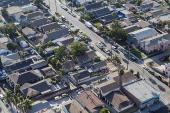More Data Show Redlining’s Lasting Impact on CVD Risk
The results could lead to the use of “correction factors” to refine triaging efforts and prioritize services for at-risk patients.

Discriminatory housing practices from more than 80 years ago have left an ongoing legacy of health disparities, including a greater likelihood of major adverse cardiovascular events, a study of US veterans with atherosclerotic cardiovascular disease (ASCVD) suggests.
In the nationwide study, veterans who lived in areas that had historically been “redlined” as part of the 1930s-era government-sponsored Home Owners’ Loan Corporation (HOLC) were more likely than those who were not to have increased risk for MACE and all-cause death, suggesting redlining carries additive CVD risk.
“To our knowledge, ours is the first study that uses patient-level information rather than summary information, which makes it more generalizable to the entire US population,” said Salil V. Deo, MD (Louis Stokes Cleveland VA Medical Center, OH), lead author of the study, which was published June 12, 2023, in JAMA Network Open. “It is quite surprising that using contemporary data from the past 5 years, still we see such significantly increased relative risk in MACE outcomes according to the redlining,” he told TCTMD.
As part of the redlining policy, the HOLC created color-coded maps to justify refusal to insure mortgages in and around Black neighborhoods, which were coded as red to demarcate high lending risk. Although redlining was abolished in the United States in the 1960s, it has been linked to modern-day racial health disparities including higher rates of stroke and cardiometabolic disease and associated risk factors in populations who continue to live in historically redlined areas.
In an editorial accompanying the study, Colleen A. Burke, PT, DPT, and Hayden B. Bosworth, PhD (both Duke University School of Medicine, Durham, NC), say the VA study “further supports the impact that long-term structural barriers have on clinical outcomes, above and beyond traditional risk factors, such as age,” and “provides the opportunity for researchers, policy makers, and clinicians to use these data in meaningful ways to create actionable movements to decrease disparities.”
14% Higher Risk of MACE, 13% Higher Risk of Death
For the study, Deo and colleagues used electronic health records and pharmacy, laboratory, geospatial, and vital status information available on 79,997 Veterans Affairs patients (mean age,74 years; 2.9% female; 55.7% Black) throughout the United States. Patients were categorized into HOLC grades A through D based on where they resided according to the original HOLC maps, with A indicative of the best neighborhoods, B still desirable, C definitely declining, and D hazardous/redlined. Approximately one-third of the veterans lived in historically redlined neighborhoods.
The prevalence of smoking and obesity increased across HOLC grades A through D, as did LDL cholesterol levels, systolic and diastolic BP, the prevalence of heart failure and chronic obstructive pulmonary disease, and community deprivation index level.
It’s like an exploding effect that has no easy answers. Salil V. Deo
At a median follow-up of 4 years, the risks of MACE (first occurrence of MI, stroke, major adverse limb event, or death) and all-cause mortality, the study’s co-primary endpoints, for those residing in redlined versus grade A neighborhoods were HR 1.14 (95% CI 1.08-1.20) and HR 1.13 (95% CI 1.07-1.19), respectively. MI risk also was higher in the redlined group, at HR 1.15 (95% CI 1.01-1.30).
The risk of MACE by HOLC grade was higher for nonwhite patients, with no significant differences between HOLC grade and MACE by ethnicity or by community deprivation index.
While adjustment for age, race, sex, ethnicity, and various comorbidities attenuated the associations between redlining and MACE and mortality, but they remained statistically significant for those in group D versus group A.
Investing in the Disinvested
Deo and colleagues note that some social determinants of health, such as economic stability, neighborhood environment, and access to education and healthcare, have been linked to poor control of CV risk factors in diabetic patients, but the associations seen in their study likely reflect many other environment health impacts of redlining.
Importantly, Burke and Bosworth say, the VA study offers a way to consider redlining when conducting observational data analyses: as something distinct from the practice of using geocoding to assess rurality. Furthermore, the new data raise questions about how to screen for and triage patients experiencing these disparities as a result of where they live, they point out.
One option, the editorialists add, is to use correction factors based on Area Deprivation Index (ADI) or historically redlined neighborhoods.
“These correction factors would be added to the triage scores of patients based on highly disadvantaged neighborhoods, such as historically redlined neighborhoods,” they write. “These patients could then be prioritized for certain treatments and other services, which would target structural inequities rather than simply triaging based on race or other sociodemographic characteristics.”
This type of triaging also could allow physicians to better advocate for increased access to assistance programs for patients and encourage more clinician participation in “social prescribing,” which involves referring patients to resources within their community to support their health and well-being, Burke and Bosworth suggest.
“Not only were these neighborhoods and areas deprived with regards to investment, but that disinvestment then led to more air pollution, more noise pollution, less amount of green space, and higher imbalance of food deserts,” Deo noted. “It’s like an exploding effect that has no easy answers . . . but what we do right now about this [can] have long-ranging effects.”
L.A. McKeown is a Senior Medical Journalist for TCTMD, the Section Editor of CV Team Forum, and Senior Medical…
Read Full BioSources
Deo SV, Motairek I, Nasir K, et al. Association between historical neighborhood redlining and cardiovascular outcomes among US veterans with atherosclerotic cardiovascular diseases. JAMA Network Open. 2023;6(7):e2322727.
Burke CA, Bosworth HB. Historical structural barriers and cardiovascular inequities. JAMA Network Open. 2023;6(7):e2322673
Disclosures
- Deo and Burke report no relevant conflicts of interest.
- Bosworth reports grants from Sanofi, Boehringer Ingelheim, Novo Nordisk, Be Better Therapeutics, Otsuka, Novartis, Improved Patient Outcomes, Esperion, Pfizer, and the Elton John Foundation paid to Duke University and personal fees from Walmart and VIDYA outside the submitted work.





Comments